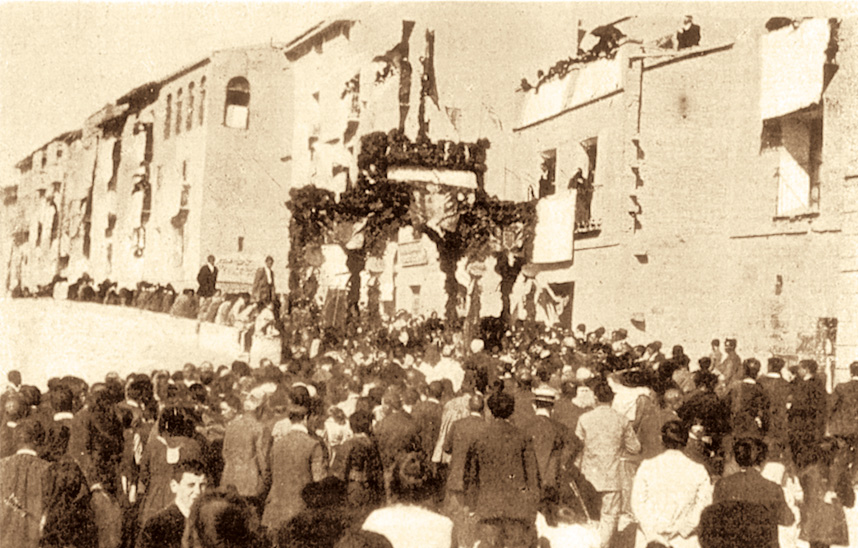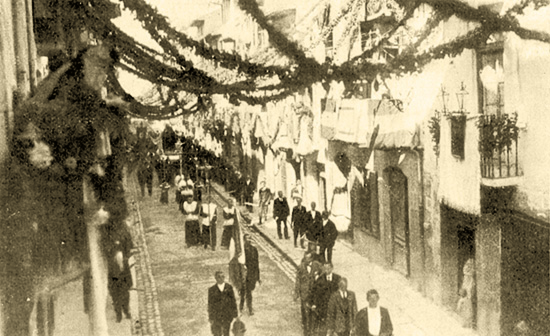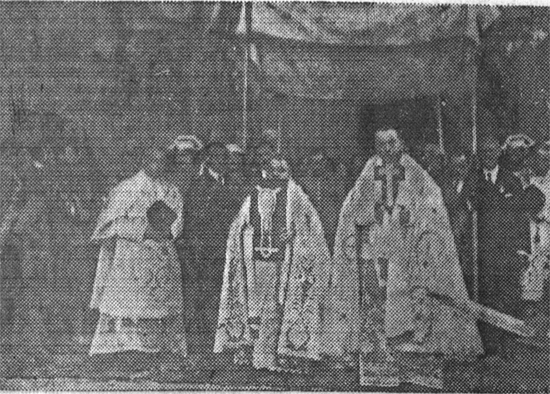Images in Navarra of the III Centenary of the canonization of Xavier (IV)

PhotoPhotofrom the Chronicle of the Centennial/Triumphal Arch erected in Viana.
For Tierra Estella
On September 20, 1922, after a three-day stay in Estella, the relic and the Christ of the Crab traveled to the city of Viana, then belonging to the bishopric of Calahorra, whose bishop Don Fidel Garcia was present together with the City Council with flag and music band, which interpreted the Royal March to the entrance in the parish of Santa Maria. In the afternoon, a procession was organized through a large triumphal arch, which immortalized the photo we present, which read "To the greatest son of Navarre". Next to the town hall were the representations of other nearby towns with their flags.
The following day, the retinue went to Sangüesa. On the way, Father Astrain discovered the relic and gave the blessing in Sansol and Torres. In Los Arcos, the chronicler affirms that "there was no other choice but to stop", in front of a people whose faith and devotion to the saint was heated. The local Jesuit, Victor Murugarren, preached, and he made the people so enthusiastic that when the people heard that there was no time to venerate the relic, "therewas no one who did not aspire, at least, to touch with their hands or rosaries the holy arm; and so the farewell procession became a longing demonstration of affection and a lively desire, powerfully expressed, to obtain the momentary contact with the saint.... ". Ignacio Baleztena, manager of the Commission on behalf of the Deputation was opening the way by force of arms, while the bearers of the relic and the Crucifix arrived sweating and panting to the car because "the people were beside themselves with pleasure and did not put limit to their yearnings". The final blessing was dispensed with because "it was necessary to dispense with everything and leave that human wave as soon as possible. Already Father Astrain, inside the car, was beginning to put the precious garment in its case, and some arms were still reaching through the windows trying to touch it ..... Finally, at about eleven o'clock, the storm not yet calmed down, the retinue could leave their radio, and drive away, with sorrow of that pious storm ... with sorrow of not being able to satisfy the hunger of those so fervent people!

Parade of the great procession through the streets of Sangüesa. Photo of the Chronicle of the Centenary
It will not be superfluous to remember that the parish of Los Arcos has several representations of the Navarrese co-patron saint, and even has a chapel with a beautiful baroque altarpiece made by Juan Ángel Nagusia in 1741. The roots of the devotion to Javier in that town were very deep.
The next stop was the monastery of Irache, where the Piarists gave a solemn reception of the relic under a canopy and the singing of the Te Deum. The report speaks of those hours spent there as an authentic haven of peace. In Oteiza, a very brief stop was made in front of people who wept for not being able to venerate the relic. In Larraga the whole town was waiting and we had to condescend. The crowd was so large that it was decided to impart the blessing from the balcony of the Town Hall, after a harangue by Father Miqueleiz.

Presidency of the procession of Sangüesa. Photo of the Chronicle of the Centenary
Towards the castle: through Ujué, Aibar and Sangüesa.
San Martín de Unx and Ujué were the next stopping points, for the inhabitants of Lerga and Eslava there was a blessing. From Sada, more than a hundred neighbors went out with candles arranged in a noticeboard to the road and were given to venerate the relic. The women of Gallipienzo went out to the road and tenaciously waited for hours, earning a few moments for the procession to stop.
The description of what happened in Aibar is from the pen of Father Antonio Astrain himself, the Jesuit historian. In a few paragraphs of fiery verbiage, he writes: "We arrived in Aibar at about seven o'clock. It was already dark. The whole town was waiting for us, and as soon as we approached, everyone began to sing the hymn of the saint with such enthusiasm as I have never seen in my life. The parish priest, under a canopy, carried the relic. The procession being so immense, it was impossible for everyone to sing in unison. The eyes could not see everything, but the ears were dazed by such a din. When the singing was near, it was felt far ahead; when the front was lowered, the songs resounded far behind, God knows where ..... Finally, all the people sang, or rather, they sang loudly, praising St. Francis Xavier". Again, Father Eustaquio Miqueleiz, a native of Ezcároz, famous orator and missionary, was in charge of haranguing the people in the parish of Aibar before imparting the blessing with the relic.

The parish priests of Santa María and Santiago de Sangüesa with the relic of the saint and the Christ of the crab in the processional parade when leaving the temple of San Salvador. Photo Uranga, published in Diario de Navarra September 23, 1922.
The town of Sangüesa received the relic that same night of September 21, with pomp, but with calm and order. This is how it is stated in the texts, as if to contrast with these last two words the enthusiasm and exaltation of Aibar that same day. From the bridge, the procession was organized and accompanied by the singing of the hymn together with the municipal band. Inside the church the relic was worshipped and the fact that he had spent part of his childhood in the city was pointed out. From Santa María the arm was taken to the Capuchinos, where it remained until five in the morning of the following day, September 22, when another procession was organized to take the relic to San Salvador. Finally, the last procession, at nine o'clock in the morning, more lucid and with a more official character was the one that was carried out massively together with the municipal authorities with the flag at the front. Hanging and bowered streets attracted attention, as well as the text that could be seen on the house that tradition pointed out as residency program of the child Javier, which read: "The neighbors of this street / where you came to study, / now glorious and holy, / we want to worship you". In the procession participated the sculpture of the saint kept in the parish of Santa Maria, according to the chronicles of the newspapers and some photographs. The parish priest of Santa María carried the reliquary and the parish priest of Santiago carried the Christ of the crab. The route was through the streets average Villa, Mayor, Plazas de Santa Catalina and Santiago, programs of study, Caballeros and Población to finish in San Salvador, where the bishop of Oviedo, Francisco Baztán, celebrated the solemn mass, but due to his fatigue he did not preside the procession. The eulogy was given at position by the aforementioned Jesuit Eustaquio Miqueleiz.
In the afternoon, the veneration of the relic and its transfer to the homes of the invalids continued. The farewell was with a blessing at place del Prado, in front of a simple altar prepared ad hoc.
LEARN MORE
EGUÍA RUIZ, C., Reliquias de San Ignacio de Loyola y San Francisco Javier. Su recorrido triunfal por España, Madrid, Blass, S. A. Tipográfica, 1924.
Diario de Navarra, September 23, 1922.
